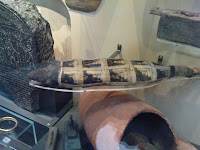 'Addables' or perhaps a more contemporary description, accessories, have functional qualities and should not just be considered as secondary to 'wearables'. They can be used to join items together e.g buttons, torques, and pins. There are an adornment that not only set of details of fashion, but can suggest or celebrate status. Ideas that could be made, bags, jewellery;bracelets, torques, necklaces, brooches.
'Addables' or perhaps a more contemporary description, accessories, have functional qualities and should not just be considered as secondary to 'wearables'. They can be used to join items together e.g buttons, torques, and pins. There are an adornment that not only set of details of fashion, but can suggest or celebrate status. Ideas that could be made, bags, jewellery;bracelets, torques, necklaces, brooches.
 'Playables' toys, models or mobiles offer instructional tools which have educational value, entertainment appeal and accessability of scale. Ideas that could be used are smaller versions of 'wearables' showing variety or sequences of design. They could also give three dimension to shapes in historic or geographical context, e.g petroglyphs. While the examples here are animal mummy's; one of a cat the other a baby alligator the fact they are wrapped in log cabin design was a surprise.
'Playables' toys, models or mobiles offer instructional tools which have educational value, entertainment appeal and accessability of scale. Ideas that could be used are smaller versions of 'wearables' showing variety or sequences of design. They could also give three dimension to shapes in historic or geographical context, e.g petroglyphs. While the examples here are animal mummy's; one of a cat the other a baby alligator the fact they are wrapped in log cabin design was a surprise.
 'Containables' shapes that display and/or hold items such as this beautifully carved sarcophagus on the right. Ideas could include vases, bowls, curved plates,boxes as container or as a display item.
'Containables' shapes that display and/or hold items such as this beautifully carved sarcophagus on the right. Ideas could include vases, bowls, curved plates,boxes as container or as a display item.With these key concepts in mind some rough ideas,inspirational visuals and paper/ fabric patterns, Ref Page 60 a and b, were collated before considering the stage of honing in on templates and design elements.
Ref Page 60 sample a Ref Page 60 sample b
A series of templates from each 'able' sector were made.
Containables:
Monymusk Reliquary inspiration with rounded top, see Ref 60b top picture in bottom left feature



Wearables & Addables:
Inspiration Golden Sequence spiral and ammonite See bottom Ref 60a to see design idea
Playables:
Dolls
While using a minature wooden artist model to make a 'clothes horse' I realised I would need to do several dolls to show the range of techniques and considered a simple shape. I was becoming concerned that the model was too small and after tackling a large piece of fabric in my samples in Chapter 12 sample B thought maybe dolls were not an option.Mobiles
I had paper patterns of birds I had cut from handmade paper, a slit is in the body through which a pleated paper is place to give wings. The model was flat but a gusset can easily make a 3d shape.
While a variety of shapes and variations of tails and feathers could be produced it maybe interesting to produce a flock of one shape with an emphasis on variation in pattern and stitch as well as different stages of flight
So now to a decision:
- The thought of an item of clothing appealed. But was concerned about scale. Clothing could always be made doll size but thought this could be a fiddly issue at the other end of the scale. I was beginning to think that big was possibly easier.
- The idea of an ammonite 'addable' was intriguing but think spirals are coming up in later modules. The idea of brooches from the petroglyhs - rock art, could always be something for the future, or as a small project.
- So after all the pondering the most likely functional items probably exist in 'containables'. From the inspiration of the Monymusk Reliquary and the Book of Deer my model chest evolved, which I thought could hold all my Distant Stitch Module sketch books, but it could also made as a smaller container. The Clamshell book cover could be used to just house my Module Two sketch book...of course it may led to making one for each module!!!
















